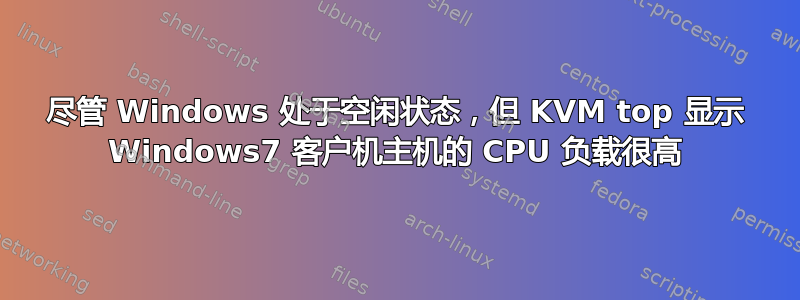
我们有一个虚拟化环境,实际上有 4 个虚拟机(2 个 Linux、1 个 W2K3、1 个 Win7)。在主机系统(Debian Jessie)中,top 始终显示 win7 客户机的 qemu 进程的 CPU 负载为 30-70%(或更多),即使客户机中的任务管理器处于零 CPU 负载。
top - 11:12:08 up 6 days, 1:47, 1 user, load average: 0,70, 0,62, 0,55
Tasks: 216 total, 2 running, 214 sleeping, 0 stopped, 0 zombie
%Cpu(s): 5,0 us, 3,7 sy, 0,0 ni, 91,3 id, 0,0 wa, 0,0 hi, 0,0 si, 0,0 st
KiB Mem: 24776900 total, 21591188 used, 3185712 free, 122680 buffers
KiB Swap: 3905532 total, 60748 used, 3844784 free. 399364 cached Mem
PID USER PR NI VIRT RES SHR S %CPU %MEM TIME+ COMMAND
11138 libvirt+ 20 0 10,804g 8,243g 18536 R 70,1 34,9 2137:30 qemu-system-x86
12134 libvirt+ 20 0 7309216 6,046g 18792 S 3,7 25,6 139:13.88 qemu-system-x86
12055 libvirt+ 20 0 8900940 4,057g 18500 S 2,3 17,2 109:41.87 qemu-system-x86
12041 libvirt+ 20 0 2956240 1,388g 18292 S 2,0 5,9 61:38.55 qemu-system-x86
5569 root 20 0 1007924 23456 11012 S 1,0 0,1 1:16.86 libvirtd
客户机内部正在运行 MSSQL 2008 R2 Express。为此设置了跟踪标志 -T8038(根据proxmox 性能调整)。此外,平板电脑设备已从配置中删除,膨胀设备在客户机内被禁用(因为我不知道如何在 VM 配置中禁用它)。此外,它还运行 Pervasive SQL 8 服务器来启动旧的 btrieve 数据库。
奇怪的是,如果我从客户机中完全移除所有 NIC,顶部的 CPU 负载会下降到适当的水平(1-3%)。实际上,作为 NIC,我通过了其中一个物理 NIC(Intel I350)。但虚拟化 NIC 的行为相同。所有这些都是在没有任何客户端连接的情况下进行的测试。
实际来宾配置:
<domain type='kvm'>
<name>win7</name>
<uuid>4b62c825-07ce-49b9-be8c-63f1f51ec28c</uuid>
<memory unit='KiB'>8388608</memory>
<currentMemory unit='KiB'>8388608</currentMemory>
<vcpu placement='static'>2</vcpu>
<os>
<type arch='x86_64' machine='pc-i440fx-2.1'>hvm</type>
</os>
<features>
<acpi/>
<apic/>
<hyperv>
<relaxed state='on'/>
<vapic state='on'/>
<spinlocks state='on' retries='8191'/>
</hyperv>
</features>
<cpu mode='host-model'>
<model fallback='allow'/>
<topology sockets='1' cores='2' threads='1'/>
</cpu>
<clock offset='localtime'>
<timer name='rtc' tickpolicy='catchup'/>
<timer name='pit' tickpolicy='delay'/>
<timer name='hpet' present='no'/>
<timer name='hypervclock' present='yes'/>
</clock>
<on_poweroff>destroy</on_poweroff>
<on_reboot>restart</on_reboot>
<on_crash>restart</on_crash>
<pm>
<suspend-to-mem enabled='no'/>
<suspend-to-disk enabled='no'/>
</pm>
<devices>
<emulator>/usr/bin/kvm</emulator>
<disk type='block' device='disk'>
<driver name='qemu' type='raw' cache='none' io='native'/>
<source dev='/dev/vg_vm/lv_win7Pro'/>
<target dev='vda' bus='virtio'/>
<boot order='1'/>
<address type='pci' domain='0x0000' bus='0x00' slot='0x03' function='0x0'/>
</disk>
<disk type='file' device='cdrom'>
<driver name='qemu' type='raw'/>
<target dev='hdb' bus='ide'/>
<readonly/>
<address type='drive' controller='0' bus='0' target='0' unit='1'/>
</disk>
<controller type='usb' index='0' model='ich9-ehci1'>
<address type='pci' domain='0x0000' bus='0x00' slot='0x04' function='0x7'/>
</controller>
<controller type='usb' index='0' model='ich9-uhci1'>
<master startport='0'/>
<address type='pci' domain='0x0000' bus='0x00' slot='0x04' function='0x0' multifunction='on'/>
</controller>
<controller type='usb' index='0' model='ich9-uhci2'>
<master startport='2'/>
<address type='pci' domain='0x0000' bus='0x00' slot='0x04' function='0x1'/>
</controller>
<controller type='usb' index='0' model='ich9-uhci3'>
<master startport='4'/>
<address type='pci' domain='0x0000' bus='0x00' slot='0x04' function='0x2'/>
</controller>
<controller type='pci' index='0' model='pci-root'/>
<controller type='ide' index='0'>
<address type='pci' domain='0x0000' bus='0x00' slot='0x01' function='0x1'/>
</controller>
<controller type='virtio-serial' index='0'>
<address type='pci' domain='0x0000' bus='0x00' slot='0x05' function='0x0'/>
</controller>
<serial type='pty'>
<target port='0'/>
</serial>
<console type='pty'>
<target type='serial' port='0'/>
</console>
<channel type='spicevmc'>
<target type='virtio' name='com.redhat.spice.0'/>
<address type='virtio-serial' controller='0' bus='0' port='1'/>
</channel>
<input type='mouse' bus='ps2'/>
<input type='keyboard' bus='ps2'/>
<graphics type='vnc' port='-1' autoport='yes'/>
<video>
<model type='qxl' ram='65536' vram='65536' heads='1'/>
<address type='pci' domain='0x0000' bus='0x00' slot='0x02' function='0x0'/>
</video>
<hostdev mode='subsystem' type='pci' managed='yes'>
<source>
<address domain='0x0000' bus='0x07' slot='0x00' function='0x1'/>
</source>
<address type='pci' domain='0x0000' bus='0x00' slot='0x07' function='0x0'/>
</hostdev>
<memballoon model='virtio'>
<address type='pci' domain='0x0000' bus='0x00' slot='0x06' function='0x0'/>
</memballoon>
</devices>
</domain>
有什么建议可以说明是什么原因造成这种情况以及如何改善?
答案1
我以前也遇到过类似的问题,客户机中 IRQ 风暴,主机负载很高。您必须隔离客户机中正在风暴 CPU 的是什么。主要候选对象是 MSSQL 实例和 hal.dll 库。
要调试,请按照下列步骤操作:
- 停止 MSSQL 实例。主机负载是否减少?如果是,则您找到了罪魁祸首。关键是 MSSQL 使用高计时器频率(1ms),即使在空闲时也是如此。在裸机上这不是问题(系统只会使用更多瓦特),但在虚拟化上可能是一个问题。如果可能,您应该确定 Windows 正在使用的计时器源,并尝试在可用计时器源之间切换。作为一种解决方法,存在一个补丁来将时钟计时器中断提高到 12ms。有关更多信息,请参阅这里和这里。
- 如果第 1 点没有带来任何好处,那么问题可能与 HAL 有关。我看到您使用了两个 vCPU;尝试使用单个 vCPU 启动 VM。这有什么改变吗?如果没有,请截取 Windows 硬件选项卡的屏幕截图(展开 HAL 节点)并在此处报告。
编辑:好的,看来 MSSQL 和 HAL 都不是导致您主机负载过高的根本原因。继续进行第二个调试阶段:
- 停止虚拟机并从其定义中删除所有 USB 设备。重新启动机器并检查主机负载:它发生了变化吗?
- 如果没有,请使用
powertop实用程序监控主机的 CPU 活动。在这里您应该看到哪些软件例程/中断服务最多。运行 30 秒并在此处报告。
答案2
我找到了罪魁祸首。我们有一个 USB-over-IP 服务器(朗新LCS-US204) 在我们的环境中。客户端软件安装在该特定 VM 上。卸载客户端软件后,主机上的 CPU 负载降至适当的水平。似乎它一直在搜索连接。删除所有 virtio-serial 设备带来了另一个小改进,现在当 Windows 空闲时,主机负载约为 2-3%。感谢您的帮助。



